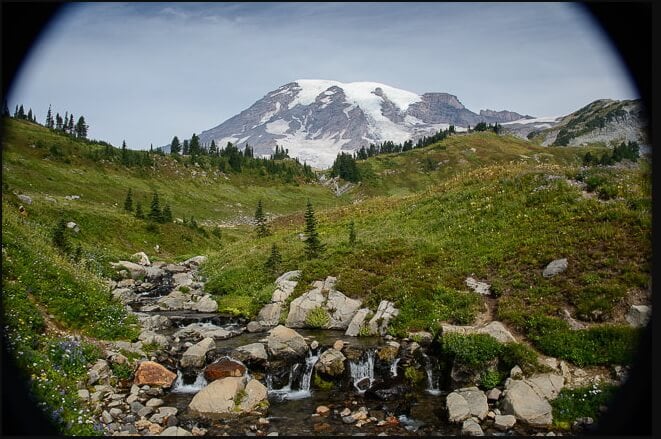What is Vignetting and How to Use It To Take Better Photos?
May 12, 2025• Proven solutions
Being a photographer means that you have to be able to use different photographic techniques effectively and creatively in your work. Vignetting or Light Falloff is a common optical phenomenon that over time became so widely used that a lot of contemporary photographers would tell you that darkening the edge of a shot is a mistake. And, they would be right to a certain degree, but this doesn’t mean that vignetting should be avoided at all cost. On the contrary, it just implies that you have to plan your shot carefully and decide if darkening its edges is the best creative decision you can make at that moment. Read on if you would like to learn about what vignetting is and how you can use it to improve your photographic skills.
- Part 1: Why Does Vignetting Occur?
- Part 2: How to Create a Vignette effects?
- Part 3: Tips to Help You Create Beautiful Vignettes in Your Photos
- Part 4: When to Use Vignettes?
Why Does Vignetting Occur?

Image from Internet
Everything in the process of taking photos is connected to the light in one way or the other, which suggests that vignetting is the result of how much light comes into the camera and how that light is distributed on a camera sensor or film. There are several different types of vignettes that can either occur naturally or as a result of the use of camera accessories.
Optical Vignetting - All lenses create vignettes, but wide-angle lenses and prime lenses that have large apertures are more likely to darken the edges of a photo. Ultimately, whether or not a lens will create a vignette depends on the aperture settings on your camera, because at wide apertures the light that enters the lens is blocked, to a certain extent, by the lens barrel. Light rays that travel at acute angles get reflected by the lens and the resulting image has the darkened edges and the correctly exposed center. Even though you can use any lens to create a vignette, a prime or an ultra wide-angle lens is a better choice than a telephoto lens.
Accessory Vignetting - To avoid using large apertures every time you want to create a vignette, you can try mounting a filter to your camera lens. Some wide-angle lenses also have built-in lens hoods that block the light from entering a lens at an acute angle. This prevents ghosting and lens flare, but lens hoods are rarely the source of vignetting, since filter holders, filters and other accessories are frequently used to purposely darken the edges of a shot.
Artificial Vignetting - Adding a vignette during the post-production is one of the most basic photo editing techniques. Nearly all photo editing software products, regardless of how powerful they are, offer at least some vignetting tools. These tools can be quite useful if you want to enhance the colors in a photo and darken its edges only slightly so that the effect is barely visible. The options provided by vignette properties in a video editing app are virtually endless, and it is up to you to find a creative way of using them to enhance a photo.
How to Create a Vignette With a Photo Camera?
There is absolutely no reason to create vignettes with your camera if you are just starting out as a photographer because you can add a vignette to a photo in post-production. What’s more, if you are shooting in JPEG mode and not in RAW, you may have trouble recovering the edges of a vignetted photo. You have to be absolutely sure that you want to darken the edges of a photo before you press the Shutter button, since once you do, reducing the vignetting effect, may prove to be difficult.
In order to create a vignette with a photo camera, you either have to increase the aperture or use an accessory that is going to prevent the light from reaching the edges of the camera sensor. Depending on the lens you’re using vignetting can occur on different focal lengths, and you have to try out several combinations of aperture, exposure and focal length settings to get the best possible result. Even though wide-angle lenses create vignettes, the scenes you can shoot with such a lens aren’t necessarily perfectly suited for this effect. Adding a vignette to a landscape or any other photo that depicts a wide space can accidentally conceal a perfect detail the camera caught. Vignetting reduces the amount of space you have in the shot, which is why you have to rely on the central composition and place all the important figures and objects near the physical center of a shot.
Tips to Help You Create Beautiful Vignettes in Your Photos
Don’t panic if at first, you fail to create a vignette with your camera or if you don’t like the result. Keep trying and with time and practice, you will get better at vignette photography. Here are a few tips that might help you create beautiful vignettes.
1. Choose Your Subjects Carefully
Adding a vignette to a shot of a busy downtown street can prove to be a great and a terrible idea at the same time. Which one it turns out to depend on what is in the shot and how the frame is composed. If you’re trying to draw the viewer’s attention to a particular detail of a busy street, then a vignette can help you reduce the number of visual elements in the shot. On the other hand, if you would like to capture the movement and the dynamics of such a scene, then darkening the edges of a shot can be counterproductive.
2. Use the Right Lens
Once you know where to point your camera, you can pick a lens that will enable you to create a vignette effortlessly. As we already mentioned prime or wide-angle lenses are more likely to darken the edges of a photo, but ultimately you can use any lens that enables you to set high apertures. Your choice of a lens shouldn’t be based solely on the effect you’re trying to create, but rather on its ability to produce high-quality images. Furthermore, accessories like lens hoods and filters can help you create a vignette, and you can remove them from the lens when you want to preserve the edges of a photo.
3. Don’t Rely on Post-Production Too Much
Plan your shot before you take it. You can add a vignette to any photo in post-production, but some photos are just not well-suited for the vignetting effect. Darkening the edges of shots that are not centrally composed doesn’t always produce the best results, because you can end up covering an important part of a picture. That’s why it is important to plan the photo in advance and know which area of the shot is going to be darkened.
4. Be Inventive
Adding a vignette to each portrait you take won’t do miracles for your career in photography, simply because it is the most expected thing you can do. Instead of trying to replicate the styles of other photographers, try to develop your own style. There are no rules regarding how you should use vignetting in your work, and it is up to you to come up with creative ways of incorporating a vignette into a photo.
When to Use Vignettes?
You shouldn’t waste your time thinking about whether or not you should use vignettes in your pictures, because there is no doubt that in certain situations this effect can be a thing a photo is missing. The real question is when and how you are going to use a vignette, because justifying obscuring parts of a shot isn’t always as simple as it seems. Photographers use all tools they have at their disposal with the purpose of producing powerful images, which is the reason why vignetting is just another tool you can use to make your photos more picturesque.
Conclusion
Getting to know the best lenses for this type of effect or which vignetting accessories you like using the most, may take time. Try adding vignettes to photos in post-production, before you start taking vignette photos, because it may help you compose your shots better. Hopefully, this article helped you improve your vignetting photography skills, so leave a comment and share your experiences with us.
You don’t necessarily have to know a lot about photo or video editing process in order to add a vignette to a picture or adjust its color, brightness or highlights. In this article we are going to ta
by Liza Brown Jun 19, 2025 17:18 PM
In this article, we are going to take you through several methods of adding vignettes to videos in Adobe Premiere Pro and we’ll also show you how to reduce camera vignetting.
by Liza Brown Jun 19, 2025 17:18 PM
There are a lot of online photo editing platforms that let you add a vignette to a photo effortlessly, and in this article, we are going to introduce you to some of the best free and paid options you
by Liza Brown Jun 19, 2025 17:15 PM

